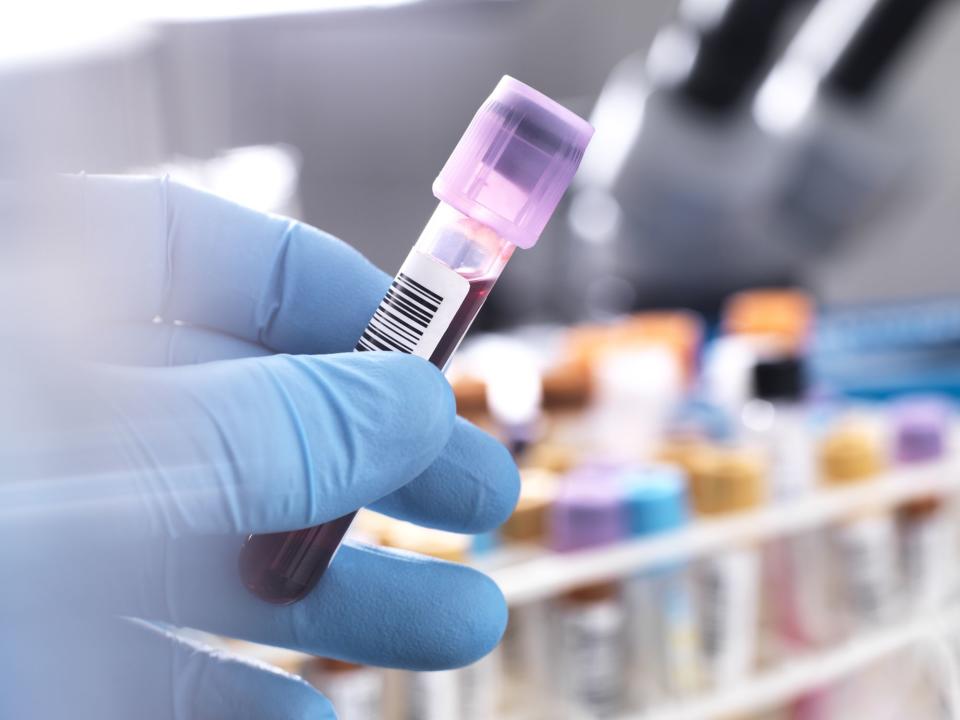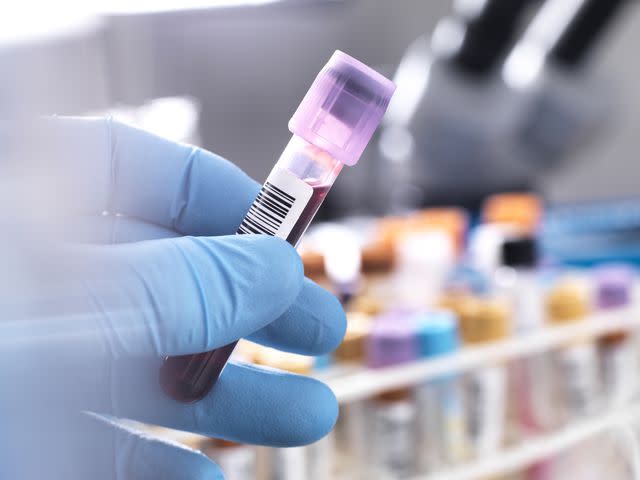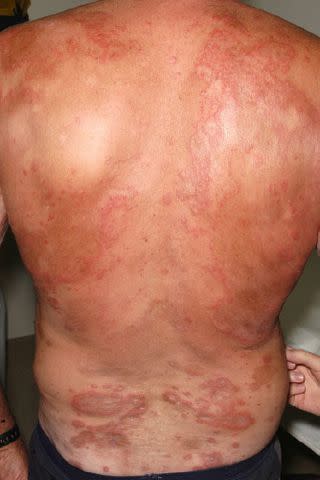Everything You Need to Know About Hypereosinophilic Syndrome
A Group of Rare Blood Disorders

Westend61 / Getty Images
Medically reviewed by Farah Khan, MD
Hypereosinophilic syndromes are a varied group of rare blood diseases. The primary factor they have in common is a very high level of a type of white blood cell called eosinophils. While usually an essential part of the immune system, too many eosinophils in various parts of the body can cause organ damage.
These syndromes can cause disease and symptoms in the skin, heart, lungs, and gastrointestinal (GI) tract. Most hypereosinophilic syndromes are not cancer. But some people may develop blood cancer (leukemia) after diagnosis.
This article covers the signs, symptoms, causes, complications, and treatment options for hypereosinophilic syndromes. It will discuss if hypereosinophilic syndromes can be cured and the link between these diseases and leukemia or cancer.

Westend61 / Getty Images
What Is Hypereosinophilic Syndrome?
Hypereosinophilic syndrome is when the body has too many eosinophils in the blood or tissues for a prolonged time. These white blood cells are typically crucial to the immune system, playing an active role in allergies and fighting off diseases, especially parasites. As part of that role, they cause inflammation.
Having too many eosinophils in the bloodstream is called eosinophilia. It can be a symptom of many diseases and conditions. People are typically diagnosed with hypereosinophilic syndrome when these other diseases are ruled out as the cause of their high levels of eosinophils.
In hypereosinophilic syndromes, the eosinophils aren’t functioning generally as immune system cells. They build up in tissues and cause damage. In these cases, healthcare providers can’t find a cause for the high number of white blood cells. They build up to high levels that can damage the body’s organs.
Studies have found that hypereosinophilic syndromes develop between 0.3 and 6.3 out of every 100,000 people.
What Causes Hypereosinophilic Syndrome?
There is no single cause of hypereosinophilic syndrome. In most cases, healthcare providers can’t find a reason for the high levels of eosinophils. Research suggests that different people develop this disease for different reasons. They may be genetic, an early sign of cancer, an unknown infection, or other health problems.
Hypereosinophilic syndromes are classified into one of six types based on the underlying cause, as follows:
Myeloproliferative or myeloid hypereosinophilic syndrome (MHES) is caused by an overgrowth of eosinophil-creating cells in the bone marrow. MHES is a part of the larger group of myeloproliferative neoplasms, diseases in which the bone marrow makes too many red blood cells, white blood cells, or platelets.
Lymphocytic variant hypereosinophilic syndrome (LHES) is caused by an overgrowth of T or B white blood cells. These cells recruit eosinophils to their location.
Overlap hypereosinophilic syndromes are typically restricted to a single organ system, or their symptoms overlap with other types.
Associated hypereosinophilic syndromes have a secondary cause, including a parasite, infection, drug hypersensitivity, or immunodeficiency. These may be classified as nonhematologic, secondary, or reactive.
Familial HES is passed down from relatives due to inherited genetic changes.
Idiopathic HES does not fall into any of the other categories.
HE of unknown significance (HEUS) is when the increase in eosinophils doesn’t cause any symptoms or damage organs.
The only known risk factor for developing hypereosinophilic syndrome is being an adult male between the ages of 20 and 50. About 90% of HES cases are males in middle age.
Most people with MHES are male, but there is no clear difference in occurrence between sexes for other types of HES. People of all sexes can get various types of HES, which has also been seen in kids. (Note that when health authorities and research are cited, the terms for sex or gender from the source are used.)
Hypereosinophilic syndrome is not leukemia. But some people who develop hypereosinophilic syndrome discover that they have a blood disorder—commonly cancer of the white blood cells called leukemia. It may take several years after hypereosinophilic syndrome is first found for healthcare providers to uncover leukemia.
What’s the Most Common Sign of Hypereosinophilic Syndrome?
A skin rash or swelling is the most common and obvious sign of hypereosinophilic syndrome. About 50% to 69% of people with hypereosinophilic syndrome have a rash. Not all people with hypereosinophilic syndrome do. It depends on what organs the eosinophils occupy.
The rash also looks different in different people. It can be red, swollen itchy lumps, like swelling under the skin (angioedema), or look more like hives or a skin allergy.

Reproduced with permission from © DermNet dermnetnz.org 2023.
Complications Associated With Hypereosinophilic Syndrome
Hypereosinophilic syndromes affect organs other than the skin. HES in the heart, lungs, stomach, intestines, and other organs can lead to organ dysfunction. Almost half (44%) of people with HES have lung symptoms, and 38% have intestinal issues. Eventually, about 20% develop heart issues.
These complications can cause additional symptoms and include:
An enlarged liver or spleen
Damage to the lungs causes trouble breathing, coughing, wheezing, and shortness of breath
Kidney damage
Heart issues, including progressive heart failure
Brain changes, resulting in memory loss or confusion
Intestinal issues and stomach problems
Blood clots that block blood flow, resulting in a heart attack or stroke
Other Signs and Symptoms of Hypereosinophilic Syndrome
Other common symptoms of hypereosinophilic syndromes include:
Weakness and fatigue
Cough
Trouble breathing
Muscle aches and pain
Swelling of the deeper layers of the skin, caused by a buildup of fluid
Fever
A runny nose, called rhinitis
How Is Hypereosinophilic Syndrome Diagnosed?
Historically, a diagnosis of hypereosinophilic syndrome requires two blood tests four weeks to six months apart that both show a blood level of more than 1,500 eosinophils per microliter.
An average blood eosinophil number is 350 to 500 per microliter. A number anywhere between 500 and 1500 may be called mild eosinophilia. Moderate eosinophilia may fall between 1,500 and 5,000 eosinophils per microliter. Severe eosinophilia is above 5,000 eosinophils per microliter.
Healthcare providers then have to rule out other causes of eosinophilia before they can diagnose HES. Common reasons for eosinophilia include:
Allergic disorders like asthma and atopic dermatitis
A reaction to a drug you're taking
Infection with parasitic worms, external parasites, protozoa, fungi, or viruses
Cancers, including leukemia, lymphoma, or adenocarcinoma
Immunodeficiencies and autoimmune disorders
Radiation exposure, cholesterol clots, Addison's disease, and IL-2 therapy with Proleukin (aldesleukin)
Ruling out these causes can require a lot of testing. This includes multiple stool samples or blood tests, allergy testing, and imaging of affected organs to rule out other causes of the symptoms. A bone marrow biopsy (removing a sample for examination in the lab) can rule out cancers or indicate an innate disease of eosinophils.
To determine the extent of the hypereosinophilic syndrome, biopsies of the skin and other organs can help identify which are affected. In tissues other than blood, an increased eosinophil number is determined by analyzing samples in the lab. HES may be diagnosed if:
Eosinophils comprise more than 20% of all nucleated cells in a bone marrow sample.
An experienced pathologist sees markedly increased numbers of eosinophils in tissue samples.
The lab finds high levels of eosinophil-derived proteins in tissues.
Genetic testing looks for changes associated with hypereosinophilic syndromes. Imaging studies, like chest X-rays and echocardiograms, assess damage to the heart and lungs. Healthcare providers will also check your liver and kidney function, vitamin B12 levels, erythrocyte sedimentation rate, and serum tryptase levels.
How Is Hypereosinophilic Syndrome Treated?
Treatment for hypereosinophilic syndrome depends on the cause of the disease. It typically focuses on lowering the high eosinophil levels in your blood and tissues to reduce the damage they do. It also aims to reduce inflammation directly and slow disease progression.
Treatments vary based on the organs that are affected. Other health issues can also complicate treatment. It can be hard to predict how serious the disease will be in a given person.
People who are not having symptoms do not need treatment. A healthcare provider will closely monitor these people for organ damage and complications.
Corticosteroids
Treatment with corticosteroids like prednisone is often the first treatment choice. With steroid use, studies have found that 70% to 85% of people see their eosinophil numbers returning to normal levels and control those levels for a long time.
This isn’t a cure, though. Eosinophilia and symptoms come back once steroids are stopped. And long-term, high-dose steroid use can lead to bone loss, infections, adrenal insufficiency, hip joint collapse, and stunted growth. Side effects include swelling, weight gain, increased appetite, diabetes, moon face (full, rounded face), and mood disturbances.
Chemotherapy
In advanced HES, chemotherapy drugs keep eosinophil numbers low by killing fast-growing cells. They can also treat blood cancers causing eosinophilia.
Chemotherapies used for HES include Hydrea (hydroxyurea). They are often used with corticosteroids or for people who do not respond to steroids.
Chemotherapy can have harmful side effects, including:
Anemia
Weakened immune system
Diarrhea
Lung inflammation
Skin rash
High blood pressure
Organ damage, including to the liver, brain, and kidneys
Cancers
Chemotherapy is used only in severe cases and requires careful monitoring.
Interferon Alpha (IFNa)
Interferon alpha is a medication injected into the fatty tissue under the skin three to five times a week. It is used for diseases including infections (like hepatitis) and cancers (like certain types of leukemia). IFNa is effective in HES by suppressing the symptoms related to the disease.
Interferon alpha can cause influenza-like side effects such as fever, chills, muscle aches, headaches, and joint pain. It can also lead to low blood counts and elevated liver enzymes that require careful monitoring and are especially problematic when a person already has liver damage from the eosinophils. About 25% to 30% of people stop taking Interferon alpha due to side effects.
Targeted Treatments
Some people with HES caused by specific genetic changes benefit from targeted treatments, specifically tyrosine kinase inhibitors like Gleevec (imatinib). Gleevec may help control the disease signs and symptoms for a period of time in people without these gene changes.
Monoclonal Antibodies
When HES does not react to traditional treatments, specific monoclonal antibody treatments may help. These include:
Nucala (mepolizumab) and CINQAIR (reslizumab) block interleukin-5 (IL-5), which governs eosinophil growth.
Lemtrada (alemtuzumab) binds to CD52 and kills eosinophils.
Can I Prevent Hypereosinophilic Syndrome?
There is no way to prevent hypereosinophilic syndromes. If you know you’re at risk, work with a healthcare provider to monitor and treat symptoms before developing organ damage.
What’s the Outlook for Hypereosinophilic Syndrome?
HES prognosis depends on what’s causing the disease. It cannot be cured, but medications can control most types. How the disease responds to these treatments plays a significant role in how the condition plays out.
Prognosis depends on what organs the eosinophils are attacking and how much damage they’ve done. If the damage is already severe, it can’t be undone, and HES may be fatal. The most common cause of death in cases of HES is heart failure. Today, more than 80% of HES patients survive five years or more.
Other causes of death for people with HES, according to studies, include infection (20%), other cancers (20%), blood clots (13%), and vascular disease (13%).
Questions to Ask Your Healthcare Provider
If you’ve been diagnosed with HES, you may consider asking your provider:
Why did I get HES?
What's my risk of developing cancer?
Can HES come back after treatment?
What are the side effects of my treatment?
What organs is my HES damaging?
Will I be cured?
Can I pass HES on to my kids?
When to See a Healthcare Provider
If you’re diagnosed with HES and your symptoms worsen, talk to your healthcare provider immediately. If you think you have signs and symptoms of HES, schedule an exam.
When to Seek Emergency Care
If you have HES and have heart symptoms like chest pain, heartburn, nausea, and swelling, go to the emergency room immediately.
Summary
Hypereosinophilic syndromes are a group of rare blood diseases. They have an abnormally high level of eosinophil white blood cells, which can cause inflammation and damage tissues and organs. The organs affected include the skin, heart, lungs, and gastrointestinal tract.
The most common sign of hypereosinophilic syndrome is a skin rash or swelling. Other symptoms include weakness, fatigue, cough, trouble breathing, muscle aches, and fever. Complications include heart failure, kidney damage, and blood clots.
Healthcare providers diagnose hypereosinophilic syndrome after ruling out other potential causes. The cause of hypereosinophilic syndromes is often unknown, but some have a genetic origin. Treatment aims to reduce eosinophil levels and inflammation. Typical treatments include corticosteroids, chemotherapy, and targeted therapies. Monoclonal antibodies can help.
Hypereosinophilic syndrome outlook depends on organ damage and response to treatment. While there is no cure, it can be managed with medications.

